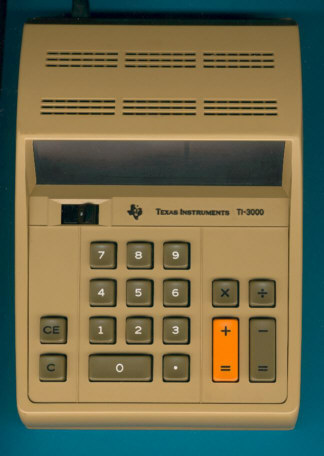
DATAMATH CALCULATOR MUSEUM
 |
DATAMATH CALCULATOR MUSEUM |
Texas Instruments TI-3000
| Date of introduction: | Sept. 21, 1972 | Display technology: | Panaplex II |
| New price: | $84.95 | Display size: | 8 |
| Size: | 8.4" x 6.2" x 2.5" | ||
| Weight: | 1 pound 14 ounces | Serial No: | 300022691 |
| Batteries: | Date of manufacture: | year 1972 | |
| AC-Adapter: | 120 V | Origin of manufacture: | USA |
| Precision: | 8 | Integrated circuits: | TMS0109 |
| Memories: | |||
| Program steps: | Courtesy of: | Joerg Woerner | |
| Download manual: | |
 The
TI-3000 desktop calculator was first announced in
April 1972 as Deskmath
LP3500. Beginning June 1972
first customers got in the Neiman-Marcus and Sanger-Harris department stores in
Dallas, TX their Deskmath LP3000 calculators before the formally
introduction on September 21, 1972. Don't miss the transitional
TI-3000 Deskmath.
The
TI-3000 desktop calculator was first announced in
April 1972 as Deskmath
LP3500. Beginning June 1972
first customers got in the Neiman-Marcus and Sanger-Harris department stores in
Dallas, TX their Deskmath LP3000 calculators before the formally
introduction on September 21, 1972. Don't miss the transitional
TI-3000 Deskmath.
The TI-3000 was introduced together with its sibling TI-3500 and the famous Datamath (TI-2500). With these calculators Texas Instruments started the business of selling calculators under their own brand. Find a reprint of the Press Release about the introduction here.
 The displays used in the early desktop models are Panaplex II
devices. Produced by Burroughs they are long-life, cold-cathode, glow-discharge
display panels. Keep your fingers away, normal voltage is about 150V. With their
orange glow they give a perfect readability even in bright ambient situations.
The keys give a perfect tactile feedback, a lot of the TI-3000 and TI-3500 are
still in daily use.
The displays used in the early desktop models are Panaplex II
devices. Produced by Burroughs they are long-life, cold-cathode, glow-discharge
display panels. Keep your fingers away, normal voltage is about 150V. With their
orange glow they give a perfect readability even in bright ambient situations.
The keys give a perfect tactile feedback, a lot of the TI-3000 and TI-3500 are
still in daily use.
Read more about Texas Instruments' "Calculator-on-a-Chip".
The second life of the TI-3000 reported is the Exactra
31.
The design of the TI-3000 was heavily influenced by the Canon L100A. Other calculators using the single-chip calculator technology introduced by Texas Instruments were the Canon L100S, Heathkit IC-2008, Radio Shack EC-1000 and Toshiba BC-0802. A different approach with more functionality was introduced with the Corvus 300E.
If you have additions to the above article please email: joerg@datamath.org.
© Joerg Woerner, December 5, 2001. No reprints without written permission.